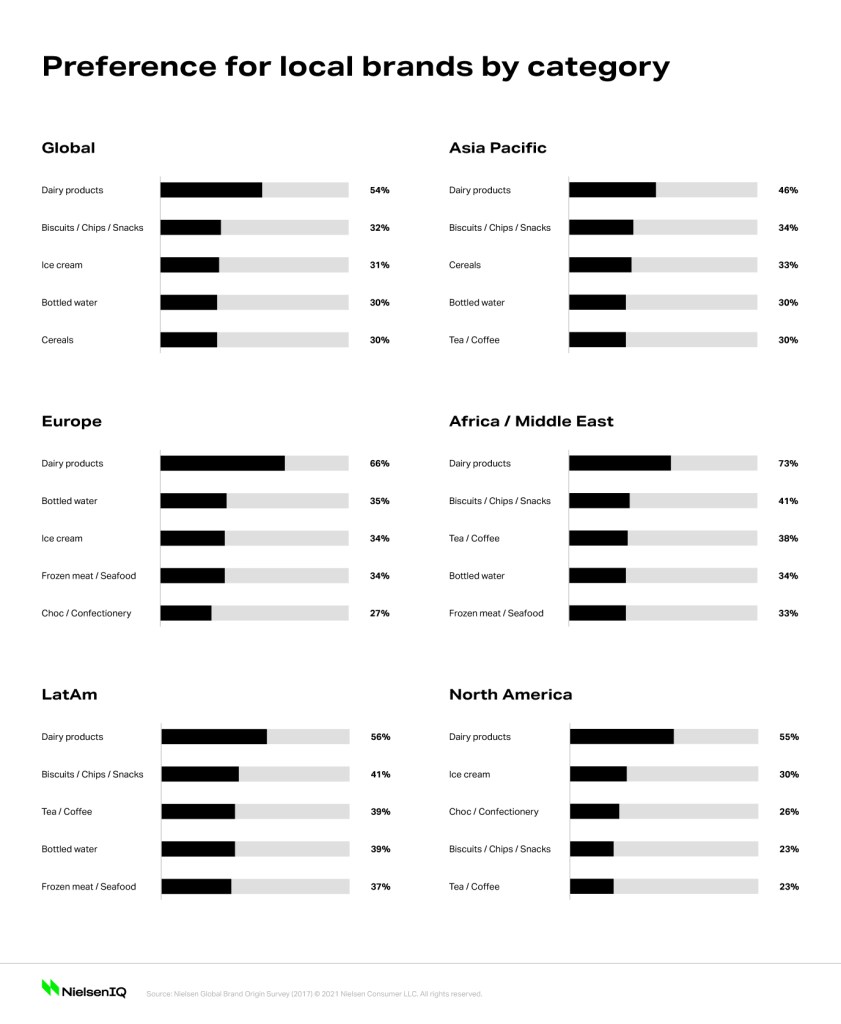Increased demand for local products
Never mind national pride: Opting for locally produced products may fast become a necessity for retailers and consumers concerned about products originating from countries where novel coronavirus (COVID-19) has spread.
Local products and brands have been gaining popularity across the globe over the past couple of years. Consumers have typically closely associated products of local origin with supporting local business, aligning with home-grown heritage, or seeking fresh foods grown close to home that meet local palate preferences. But as fears about COVID-19 spread, consumer thoughts and actions are changing around the globe—and this represents an opportunity for retailers and manufacturers that can leverage local’s appeal to mitigate consumer concerns.
Already, NielsenIQ’s ongoing investigation into the outbreak has found shoppers are exhibiting signs that they may steer away from products that travelled long distances with multiple human touchpoints, particularly products such as dairy, fruit, vegetables, and meats. And that means that products that come off factory lines or rely on distribution systems from some of the hardest hit countries could face challenges, and multinational brands will need to work to maintain consumer confidence.
Interested in more COVID-19 consumer insights? See our complete coverage.
Lockdown means ‘local’ may shine
Due to the rapid spread of COVID-19, some markets have taken extreme measures to protect their populations by issuing widespread quarantines, halting manufacturing, and disrupting supply chains. And even in some markets that haven’t taken such severe measures, demand has been disrupted due to consumer precautions. Globally, there is likely to be an impact on product and brand choices being made at the checkout due to these changes. And this impact may break longtime purchase habits irreversibly.
In recent years, consumers have generally displayed strong preferences for local dairy and fresh produce brands and products versus those coming from further afield. Amidst the ongoing COVID-19 crisis, anxieties around origins of products and ingredients are likely to fuel increased demand for even more local sourcing.
So what are consumers looking for? Firstly, they need to be reassured. More than ever, shoppers want to understand the supply chain, with complete transparency from farm to factory to distribution, and they want details of the measures being taken to assure their safety.
In some countries, expanded transparency is already becoming the norm. In China, where populations are emerging from mass quarantines and widespread concerns prevail, scooter-riding couriers from online food retailers Meituan and Eleme present customers with a reassurance guarantee slip that includes details of the body temperature of the cooks, food packagers, and couriers for every order, as well as their daily disinfecting routines. In other words, consumers are becoming used to this high level of transparency. They are likely to expect it in everything they buy, but especially when it comes to food products.

Globally-known brands hold less sway with consumers
Similarly, in the U.S., a lack of paid sick leave for many workers in retail, and the food industry in particular, has raised shoppers’ concerns and is prompting some companies to adjust their policies. By giving employees additional paid sick leave, these retailers are signaling their proactive stance in preventing the spread of the illness, as well as reinforcing their safety measures to consumers.
Promoting a product’s local origins could help manufacturers and retailers assuage some consumer concerns. A NielsenIQ survey on disloyalty last year found that global consumers report being heavily swayed by origin: 11% of global consumers said they only bought products manufactured in their country while an additional 54% “mostly” bought local products. A further 19% of global consumers said they were always influenced to try or switch brands based on local attributes, with 34% more saying they were often influenced. Yet these numbers vary across local markets, and marketers need to be aware of their country’s level of interest in local brands.
Consumers surveyed in Italy, India, Thailand, Philippines, Egypt, Saudi Arabia, United Arab Emirates, Pakistan, and the U.S. all displayed a stronger preference for local products and are likely to further increase their consumption of these products. Meanwhile, consumers in countries that did not have a strong preference either way could well now tip the demand scales in favour of local products. These include Hong Kong, Taiwan, Singapore, New Zealand, Belgium, Germany, United Kingdom, Ireland, Israel, Netherlands, Norway, Russia, South Africa, Mexico, and Costa Rica.
But marketers will need to understand the nuances of local concerns. And in this way, smaller local manufacturers may have another advantage as consumer concerns grow. With smaller operations, they may be able to respond faster and in more targeted ways than their bigger counterparts—and by doing so could win with local consumers in an appropriate and timely way. The growth of smaller players in the fast-moving consumer goods (FMCG) industry across the U.S., Italy, Portugal, Spain, Egypt, Nigeria, and Ghana has outpaced that of the bigger manufacturers in the past year. With varying levels of concern, response and impact by market, local producers, and retailers have the added edge of focusing on an individual market. They are able to take swift, focused and singular actions that are relevant to a specific marketplace.
Furthermore, big, global and known brands are holding less sway with consumers these days—less than a third (28%) of global consumers say they are influenced to try or switch brands based on these halos alone. And this could further set the stage for local brands to rise and grow, cementing future loyalty through their actions of today.
Global to double down on ‘local’
It is easy to assume that multinational companies face the biggest challenges as they come up against small, agile national brands, market supply constraints and local consumer perceptions. However, many global organizations have invested in-market with vigorous local sourcing criteria and manufacturing operations, often unbeknown to consumers, and they may be able to turn that to their advantage.
The opportunity for these brands will lie in fortifying their positioning by providing visibility into their on-the-ground operations, supported by distinct communication around their ‘equally local’ supply status. Global quality assurances, large scale production to meet stock-up demand, verified health claims, industry body certification, and track records of satisfying consumer needs could all help multinationals emphasize their origin benefits.
Depending on the duration and impact of COVID-19, there are other important implications to consider:
- Retailers may be forced to increasingly depend on local products as supply from beyond country borders is suspended and longer-term quarantines implemented.
- Retailers and manufacturers may want to consider additional protective packaging for global and local products, but will need to balance this against rising consumer concerns about environmental impact.
- Consumers may deepen their trust for locally sourced/produced products in all markets—affected and unaffected: if they can see it and identify it, they can trust it.
- Local credentials will be steadily sought out and possibly over-appreciated.
- Global companies will need to spotlight their global advantages together with their local elements amidst the heightened skepticism towards distance prone supply chains.
Driven by necessity or the need for greater transparency, local brands and retailers are optimally placed to alleviate and deliver against consumers’ product sourcing concerns. Local business will benefit from sharper messaging reinforcing supply chain visibility and focused distribution to reach consumers.
As this global health crisis continues to evolve, NielsenIQ will provide ongoing updates on the impact COVID-19 is having on consumer purchasing. Visit our content hub for the latest global consumer insights into the coronavirus outbreak.




